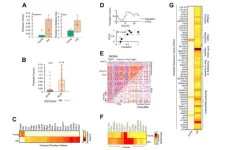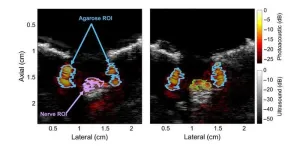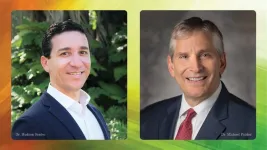(Press-News.org) A team of scientists from Ames National Laboratory developed a new machine learning model for discovering critical-element-free permanent magnet materials. The model predicts the Curie temperature of new material combinations. It is an important first step in using artificial intelligence to predict new permanent magnet materials. This model adds to the team’s recently developed capability for discovering thermodynamically stable rare earth materials.
High performance magnets are essential for technologies such as wind energy, data storage, electric vehicles, and magnetic refrigeration. These magnets contain critical materials such as cobalt and rare earth elements like Neodymium and Dysprosium. These materials are in high demand but have limited availability. This situation is motivating researchers to find ways to design new magnetic materials with reduced critical materials.
Machine learning (ML) is a form of artificial intelligence. It is driven by computer algorithms that use data and trial-and-error algorithms to continually improve its predictions. The team used experimental data on Curie temperatures and theoretical modeling to train the ML algorithm. Curie temperature is the maximum temperature at which a material maintains its magnetism.
“Finding compounds with the high Curie temperature is an important first step in the discovery of materials that can sustain magnetic properties at elevated temperatures,” said Yaroslav Mudryk, a scientist at Ames Lab and senior leader of the research team. “This aspect is critical for the design of not only permanent magnets but other functional magnetic materials.”
According to Mudryk, discovering new materials is a challenging activity because the search is traditionally based on experimentation, which is expensive and time-consuming. However, using a ML method can save time and resources.
Prashant Singh, a scientist at Ames Lab and member of the research team, explained that a major part of this effort was to develop an ML model using fundamental science. The team trained their ML model using experimentally known magnetic materials. The information about these materials establishes a relationship between several electronic and atomic structure features and Curie temperature. These patterns give the computer a basis for finding potential candidate materials.
To test the model, the team used compounds based on Cerium, Zirconium, and Iron. This idea was proposed by Andriy Palasyuk, a scientist at Ames Lab and member of the research team. He wanted to focus on unknown magnet materials based on earth-abundant elements. “The next super magnet must not only be superb in performance, but also rely on abundant domestic components,” said Palasyuk.
Palasyuk worked with Tyler Del Rose, another scientist at Ames Lab and member of the research team, to synthesize and characterize the alloys. They found that the ML model was successful in predicting the Curie temperature of material candidates. This success is an important first step in creating a high-throughput way of designing new permanent magnets for future technological applications.
“We are writing physics-informed machine learning for a sustainable future,” said Singh.
This research is further discussed in “Physics-Informed Machine-Learning Prediction of Curie Temperatures and Its Promise for Guiding the Discovery of Functional Magnetic Materials,” written by Prashant Singh, Tyler Del Rose, Andriy Palasyuk, and Yaroslav Mudryk, and published in Chemistry of Materials.
Ames National Laboratory is a U.S. Department of Energy Office of Science National Laboratory operated by Iowa State University. Ames Laboratory creates innovative materials, technologies, and energy solutions. We use our expertise, unique capabilities, and interdisciplinary collaborations to solve global problems.
Ames Laboratory is supported by the Office of Science of the U.S. Department of Energy. The Office of Science is the single largest supporter of basic research in the physical sciences in the United States and is working to address some of the most pressing challenges of our time. For more information, please visit https://energy.gov/science.
END
Researchers use AI to find new magnetic materials without critical elements
2023-09-05
ELSE PRESS RELEASES FROM THIS DATE:
Aging alters pancreatic circadian rhythm
2023-09-05
“Overall, our study identified previously unknown circadian transcriptome reorganization of pancreas by aging [...]”
BUFFALO, NY- September 5, 2023 – A new research paper was published in Aging (listed by MEDLINE/PubMed as "Aging (Albany NY)" and "Aging-US" by Web of Science) Volume 15, Issue 16, entitled, “Reorganization of pancreas circadian transcriptome with aging.”
The evolutionarily conserved circadian system allows organisms to synchronize internal processes with 24-h cycling environmental timing cues, ensuring optimal adaptation. Like other organs, the pancreas function is under circadian control. Recent evidence ...
Visualizing nerves with photoacoustic imaging
2023-09-05
Invasive medical procedures, such as surgery requiring local anesthesia, often involve the risk of nerve injury. During operation, surgeons may accidentally cut, stretch, or compress nerves, especially when mistaking them for some other tissue. This can lead to long-lasting symptoms in the patient, including sensory and motor problems. Similarly, patients receiving nerve blockades or other types of anesthesia can suffer from nerve damage if the needle is not placed at the correct distance from the targeted peripheral nerve.
Consequently, researchers have been trying to develop medical imaging techniques to mitigate the risk of nerve damage. For instance, ultrasound and magnetic resonance ...
Study of “revolving door” in Washington shows one-third of HHS appointees leave for industry jobs
2023-09-05
LOS ANGELES – Almost one-third of government appointees to the Department of Health and Human Services (HHS) leave to take jobs in private industry, according to a study by the USC Schaeffer Center for Health Policy & Economics and Harvard University.
The study, published in Health Affairs, is the first to quantify the personnel movement between health-care industries and the government agencies that regulate them, according to the authors. Although there are understandable reasons for people to move between the public and private sectors, the study notes that such a revolving door could make government agencies more vulnerable to pro-industry bias.
“Laws passed ...
DOACs reduce dementia risk in Asian AFib patients compared to traditional blood thinners
2023-09-05
The use of direct oral anticoagulants (DOACs) was associated with a reduction in dementia risk compared to traditional blood thinners—like warfarin—in atrial fibrillation patients, particularly in Asian patients. According to a study published today in JACC: Asia, this benefit may reverse with increased age and necessitates further follow-up study.
“Asian patients are more likely to be sensitive to vitamin K antagonism, which puts them at high risk for bleeding events, contributing to dementia development ...
New research sheds light on origins of social behaviors
2023-09-05
ITHACA, N.Y. – Male fruit flies don’t usually like each other. Socially, they reject their fellow males and zero in on the females they discern via chemical receptors – or so scientists thought.
New research from Cornell University biologists suggests the fruit fly’s visual system, not just chemical receptors, are deeply involved with their social behaviors. The work sheds light on the possible origin of differences in human social behaviors, such as those seen in people with bipolar disorder ...
New Chagas research unravels decades-long mystery of how the tropical disease progresses
2023-09-05
New research from Tulane University may shed light on how parasite strain diversity can impact Chagas disease progression and severity.
Chagas, a lesser-known and studied tropical disease, is caused by Trypanosoma cruzi parasites, which are transmitted by kissing bugs. In the Americas, the disease affects 6 million people in 21 countries, with approximately 30,000 new cases each year. While most infected patients remain asymptomatic, about 20-40 percent of those infected will develop chronic heart disease ...
Electrifying heavy-duty vehicles could reduce environmental inequalities
2023-09-05
New simulations model traffic-related air pollution over the region surrounding Chicago, North America’s largest freight hub
In the simulations, the researchers modeled a scenario in which 30% of current on-road heavy-duty vehicles (HDVs) were replaced by electric HDVs
Electrifying HDVs would substantially reduce air pollution and save hundreds of lives annually in the region, with particularly large health benefits in predominantly Black, Hispanic and Latinx communities
The region also would save nearly $6 billion annually in avoided ...
Large Kaiser Permanente study could lead to better management for patients with aortic stenosis
2023-09-05
The diagnosed severity of aortic stenosis strongly correlates with clinical outcomes, new Kaiser Permanente research shows. But the study also suggests that fine-tuning physician assessment of those patients with moderate aortic stenosis could help improve outcomes and better determine which patients might benefit from surgery.
The study found that patients diagnosed with moderate aortic stenosis have outcomes most similar to those categorized with mild aortic stenosis while only those with moderate-to-severe aortic stenosis had outcomes similar to those with ...
Landmark NIH grant awarded to School of Nursing and Health Studies
2023-09-05
The University of Miami School of Nursing and Health Studies (SONHS) has been awarded an unprecedented $23.57 million grant from the National Institutes of Health (NIH) to join the Environmental influences on Child Health Outcomes (ECHO) Program.
The interdisciplinary grant, the largest award to date in the Coral Gables Campus’ history, is funding an ambitious project spearheaded by Hudson Santos, RN, PhD, FABMR, FAAN, the lead Principal Investigator and Vice Dean for Research Affairs, with Professor Michael Paidas, MD, chair of the University of Miami Miller School of Medicines Department of Obstetrics, ...
Study reveals disparities within NHS leadership
2023-09-05
New research shows that Allied Health Professions (AHPs) are significantly underrepresented in senior leadership roles despite being the third largest workforce in the NHS.
Ranging from paramedics to podiatrists, the AHPs encompass various healthcare disciplines, constituting a workforce of 185,000 within the NHS.
However AHPs have historically been underrepresented in strategic leadership positions, often occupied by medical professionals. To address this, NHS England advocated for the establishment of a Chief AHP role in every Trust to harness the untapped potential of this workforce and increase diversity in leadership ...



